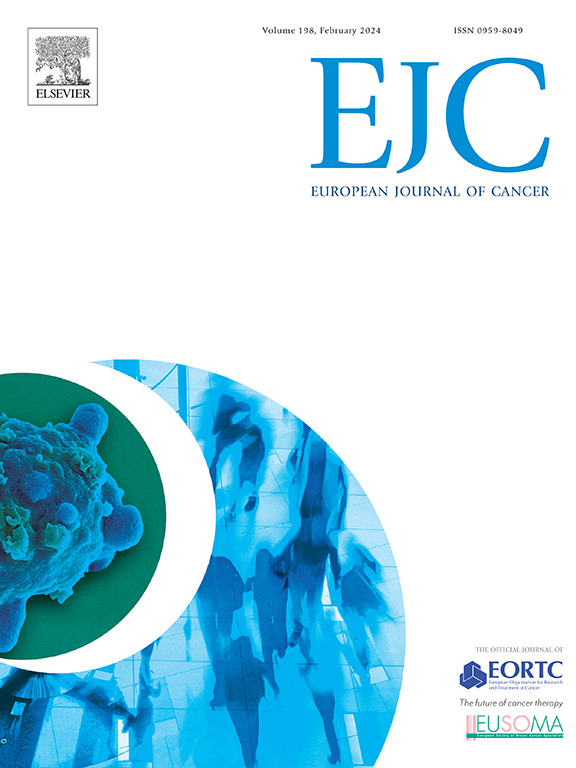Reduction in surgical interventions in melanoma
IF 7.6
1区 医学
Q1 ONCOLOGY
引用次数: 0
Abstract
Melanoma surgery has evolved from elective lymph node dissection (ELND) to sentinel lymph node biopsy (SLNB) and wide local excision (WLE) margins have come down from 5 cm to nowadays 1 – 2 cm. Recent studies have illustrated the low frequency of residual tumour cells in WLE specimen, particularly for pT2 or lower tumours, where 97 % of patients cannot benefit from WLE. Moreover, a cohort of completely excised primary melanomas did not seem to have inferior clinical outcomes to those who did undergo WLE. Biomarkers, such as clinicopathological gene expression profilers (CP-GEP), can stratify high- and low-risk disease and make therapy decisions, in particular in clinical stage I/II melanoma and make sentinel lymph node biopsy (SLNB) largely redundant. Also SLNB needs to be reconsidered due to the lack of a clear overall survival benefit for adjuvant therapy in stage III. Moreover SLNB is redundant in stage IIB/C for decision making on adjuvant anti-PD1 therapy. Moreover the superiority of neo-adjuvant to salvage patients with macroscopic stage III over adjuvant therapy leads to sharp reduction of therapeutic lymph node dissections (TLND). Overall, the major impact of current developments is that SLNB might soon become obsolete and may be replaced by standard CP-GEP testing of the primary for clinical management, reduction of surgical interventions and simplification of follow up schedules in low risk patients. Thus, we are on the eve of a significant reduction in surgical interventions for melanoma that will come in the upcoming years.
减少黑色素瘤的手术干预。
黑色素瘤手术已经从选择性淋巴结清扫(ELND)发展到前哨淋巴结活检(SLNB),广泛局部切除(WLE)的边缘已经从5 厘米下降到现在的1 - 2 厘米。最近的研究表明,WLE标本中残留肿瘤细胞的频率很低,特别是对于pT2或更低的肿瘤,其中97% %的患者不能从WLE中获益。此外,一组完全切除的原发性黑色素瘤患者的临床结果似乎并不比那些接受WLE的患者差。生物标志物,如临床病理基因表达谱仪(CP-GEP),可以对高风险和低风险疾病进行分层,并做出治疗决定,特别是在临床I/II期黑色素瘤中,并使前哨淋巴结活检(SLNB)在很大程度上是多余的。此外,由于III期辅助治疗缺乏明确的总体生存获益,因此需要重新考虑SLNB。此外,SLNB在IIB/C期对于辅助抗pd1治疗的决策是多余的。此外,与辅助治疗相比,新辅助治疗在挽救宏观III期患者方面的优势导致治疗性淋巴结清扫(TLND)的急剧减少。总的来说,目前发展的主要影响是SLNB可能很快就会过时,并可能被标准的CP-GEP测试所取代,用于临床管理,减少手术干预,简化低风险患者的随访计划。因此,我们正处于黑色素瘤手术治疗将在未来几年显著减少的前夜。
本文章由计算机程序翻译,如有差异,请以英文原文为准。
求助全文
约1分钟内获得全文
求助全文
来源期刊

European Journal of Cancer
医学-肿瘤学
CiteScore
11.50
自引率
4.80%
发文量
953
审稿时长
23 days
期刊介绍:
The European Journal of Cancer (EJC) serves as a comprehensive platform integrating preclinical, digital, translational, and clinical research across the spectrum of cancer. From epidemiology, carcinogenesis, and biology to groundbreaking innovations in cancer treatment and patient care, the journal covers a wide array of topics. We publish original research, reviews, previews, editorial comments, and correspondence, fostering dialogue and advancement in the fight against cancer. Join us in our mission to drive progress and improve outcomes in cancer research and patient care.
 求助内容:
求助内容: 应助结果提醒方式:
应助结果提醒方式:


